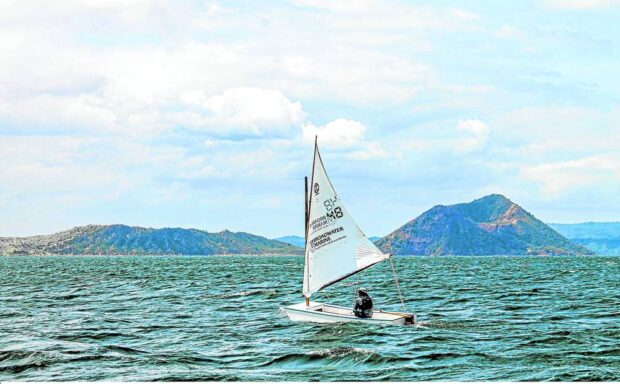
TRANQUIL A small sailboat navigates the gentle ripples of Taal Lake in this photo taken on April 9. Taal Volcano, which sits in the middle of the lake, continuously emits high concentrations of volcanic sulfur dioxide since March 2021 and emissions since September have averaged 5,019 metric tons per day. —PHOTO COURTESY OF TALISAY TOURISM OFFICE
LUCENA CITY—After recording a year-high volume of sulfur dioxide (SO2) emissions last week, Taal Volcano’s alarming release of harmful gas has partially subsided, according to the Philippine Institute of Volcanology and Seismology (Phivolcs).
A total of 6,179 metric tons (MT) of SO2 from Taal’s main crater was measured over the past 24 hours and rose to 900 meters tall before drifting southwest, Phivolcs said in its 5 a.m. bulletin on Monday.
It was also lower than the 6,342 MT of SO2 logged on Sunday, the agency said.
Taal’s SO2 emission reached 11,499 MT on Nov. 9, the highest so far this year.
It was on Oct. 12 when Phivolcs noted an increase in emission of SO2 (9,762 MT) from the main crater of the volcano that sits on Taal Volcano Island (TVI), locally known as “Pulo,” in the middle of Taal Lake in Batangas province.
Phivolcs reported that Taal Volcano has been continuously degassing high concentrations of volcanic SO2 since March 2021 and emissions since September have averaged 5,019 MT per day.
The high level of SO2 emissions and sporadic steam releases have caused volcanic smog or “vog”—a harmful haze that contains volcanic ash and gas—to descend on localities close to the volcano, which had prompted local governments to cancel classes as it could cause health issues, particularly those suffering from asthma and other respiratory ailments.
Residents of localities around Taal Volcano were also asked by authorities not to let their guard down even during the times when there are no visible smog and to keep a supply of face masks on hand as protection against vog.
Barred
Authorities have barred entry into Pulo, especially within the vicinity of the main crater and the Daang Kastila fissure. Aircraft are still prohibited from flying close to the volcano.
Taal Volcano remained under alert level 1 (low level of volcanic unrest), according to the state volcanologist.
Phivolcs reminded the public that Taal Volcano continued to display an “abnormal condition” and “should not be interpreted to have ceased unrest nor ceased the threat of eruptive activity.”
Under alert level 1, sudden steam-driven or phreatic explosions, volcanic earthquakes, minor ashfall, and lethal accumulations or expulsions of volcanic gas can occur and threaten areas within TVI, Phivolcs said.

